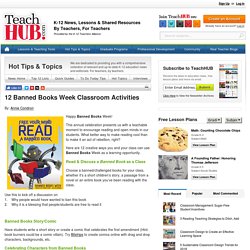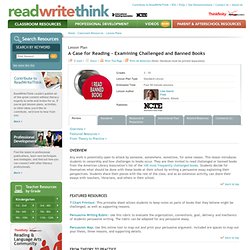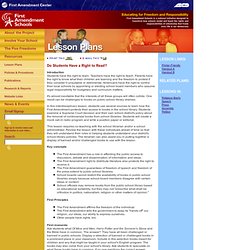

Banned Books Week. NCTE's Support for the Students' Right to Read NCTE Actively Began Fighting Censorship in the 1950’s McCarthyism spurred NCTE to take a more active stance against censorship and in 1953, NCTE's Committee on Censorship of Teaching Materials published Censorship and Controversy, condemning McCarthy's tactics and championing freedom of thought.

In 1962 NCTE published its seminal intellectual freedom guideline: The Students' Right to Read leading up to today’s active Anti-Censorship program which works with 60-100 educators and school districts a year on challenges to texts used in classrooms. Over the years the Council has voiced its opposition to censorship and promoted intellectual freedom as portrayed in this video clip from the NCTE Centennial Film. Participate in this year's Banned Books Week: September 22-28, 2013. A Look at the History of Book Banning in America. By Thaisi DaSilva and Veronica DeVore, PBS NewsHour Subject(s) English, Language Arts Estimated Time One 45-minute class period Grade Level Objective Students will gather background information about banned books and will explore reasons why they were banned.

Overview Throughout history, books have been banned for a host of reasons, from politically controversial content to profane language or violence. Background Each year, National Banned Books Week brings attention to books that have been banned or challenged in the past and that, in some cases, continue to draw criticism for their content. Procedure Activity 1 Have students view the above slide show and discuss which of the books they have read and/or are familiar with.
Types of Objections Against Books Profanity. Read a letter protesting censorship of a student poetry reading due to objections of profanity. 12 Banned Books Week Classroom Activities. Happy Banned Books Week!

This annual celebration presents us with a teachable moment to encourage reading and open minds in our students. What better way to make reading cool than to make it an act of rebellion, right? Here are 12 creative ways you and your class can use Banned Books Week as a learning opportunity. Read & Discuss a Banned Book as a Class Choose a banned/challenged books for your class, whether it’s a short children’s story, a passage from a novel or an entire book you’ve been reading with the class. Use this to kick off a discussion on 1. Banned Books Story/Comic Have students write a short story or create a comic that celebrates the first amendment (Hint: book burners could be a comic villain).
Five-Minute Film Festival: Banned Books. A Case for Reading - Examining Challenged and Banned Books. Overview Featured Resources From Theory to Practice Any work is potentially open to attack by someone, somewhere, sometime, for some reason.

This lesson introduces students to censorship and how challenges to books occur. They are then invited to read challenged or banned books from the American Library Association’s list of the 100 most frequently challenged books. Back to top T-Chart Printout: This printable sheet allows students to keep notes on parts of books that they believe might be challenged, as well as supporting reasons. Persuasive Writing Rubric: Use this rubric to evaluate the organization, conventions, goal, delivery, and mechanics of students' persuasive writing. Persuasion Map: Use this online tool to map out and print your persuasive argument. There are times that the books that are part of our curriculum are found to be questionable or offensive by other groups.
What then should the English teacher do? Further Reading National Council of Teachers of English. 1981. Get ready to celebrate Banned Books Week! Lesson. Do Students Have a Right to Read?

Introduction Students have the right to learn. Teachers have the right to teach. Parents have the right to know what their children are learning and the freedom to protest if they consider it unsuitable or detrimental. Americans have the right to control their local schools by appointing or electing school board members who assume legal responsibility for budgetary and curriculum matters. It's almost inevitable that the interests of all these groups will often collide. In this interdisciplinary lesson, students use several sources to learn how the First Amendment protects their access to books in the school library. This lesson requires co-teaching with the school librarian and/or a school administrator. Key concepts The First Amendment has a role in affording the public access to discussion, debate and dissemination of information and ideas. First Principles The First Amendment affirms the freedom of the individual. Procedure 1. For example: 2. 3. 4. 5. 6.